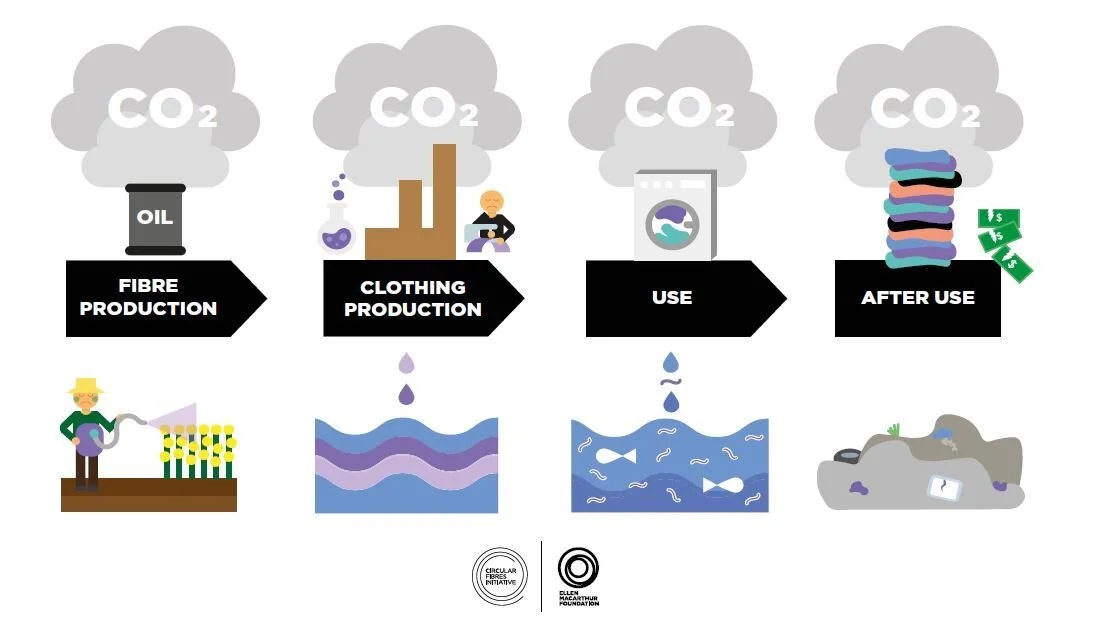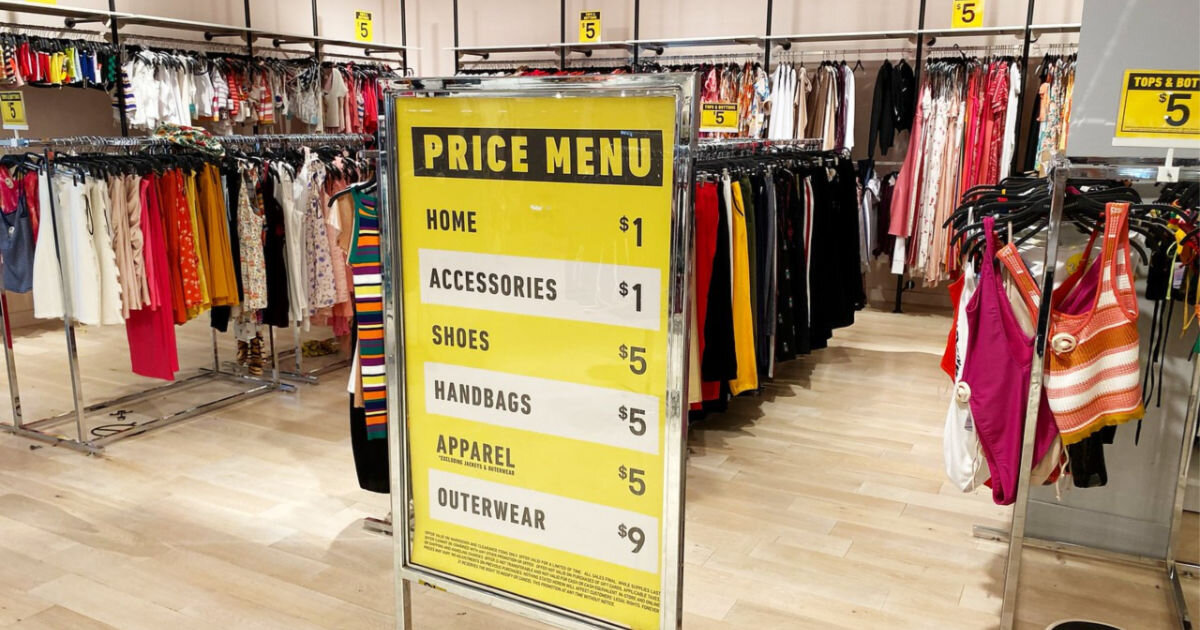10 FAQ's About Fast Fashion That Literally Everyone Asks
The phrase fast fashion has been thrown around a lot in the fashion industry in recent years. It's just part of the growing number of environmentally-friendly buzzwords like sustainable fashion, slow fashion, and green fashion that can feel a bit vague.
In this guide navigating the growing sustainable fashion movement, we'll answer the most commonly asked questions about fast fashion and its damaging effects on the environment.
Below, we answer the ten most commonly asked questions about fast fashion.
What is fast fashion?
According to Good on You, fast fashion can be defined as "cheap, trendy clothing that samples ideas from the catwalk or celebrity culture and turns them into garments in high street stores at breakneck speed to meet consumer demand."
The goal of fast fashion is to accelerate the design and production process to get new styles on the market as quickly as possible. While it used to take clothing brands three to six months to put out new products, some fast fashion brands like Zara can take a style from the initial sketch to the final product in just over two weeks.
Throughout the 20th century, most consumers went clothes shopping only a handful of times each year. As trends became shorter and clothes became cheaper, shopping became a hobby instead of an occasional splurge. Now, with new styles arriving weekly, fast fashion customers must continually shop for new items in order to stay relevant.
Fast fashion also owes a big thanks to social media and fashion bloggers. Influencer culture helped speed up the trend cycle and made wearing the same outfit twice on your feed a fashion faux pas. Instead of viewing our clothes as highly valuable possessions, we've come to view them as disposable.
Why is fast fashion bad?
As these fast fashion statistics will prove, our current fashion industry has created a toxic system based on consumption, overproduction, exploitation, and waste. The pressure to maximize profits causes fast fashion companies to use unethical and unsustainable business practices to serve up short-lived trends at affordable prices.
To meet customer demands for low prices, fast fashion companies take advantage of cheap labor in countries that lack adequate workers' rights and safety regulations. The lack of environmental regulations in these countries also means that companies can cut costs by using dangerous chemicals and toxic dyes to create low-priced fabrics.
These cheap, trendy garments are designed to be worn only a handful of times before being discarded. After a few wears, the garment either falls apart or goes out of style, encouraging customers to return to the store to shop for new trends.
Unfortunately, the majority of fast fashion garments are made with synthetic fibers that don't degrade over time in landfills. Thanks to the normalization of this overconsumption, the fashion industry has become one of the biggest contributors to global waste and pollution.
What makes a brand fast fashion?
It can be difficult for the untrained eye to spot a fast fashion brand at first, especially if the brand is adept at greenwashing. But once you understand what makes a brand fast fashion, you'll quickly see that most popular clothing brands could be considered part of the problem.
Here are a few common traits that most fast fashion brands have:
Offshore manufacturing that takes advantage of cheap labor in countries with few wage and safety regulations, often using complex global supply chains with little to no transparency
Inexpensive, low-quality materials designed to quickly degrade and be thrown away after a single season
Hundreds to thousands of different styles, most of which are focused on current fashion trends
Limited quantities of trendy garments to avoid markdowns and pressure shoppers into buying immediately before they miss out
Short turnaround time between when the trend was first spotted on a runway, red carpet, or celebrity Instagram feed and when it hits the stores
It's a common misconception that all fast fashion brands have low prices. While advertising unbelievably low prices is a major red flag, there are a number of mid-priced fast fashion companies that use the same dangerous tactics.
What stores are considered fast fashion?
Unfortunately, many of the biggest players in the fashion industry are fast fashion brands. Many boast humble beginnings in the 70s and 80s as small European shops, but thanks to globalization in the 90s, these family-owned shops quickly grew into multi-billion dollar international empires.
Zara, H&M, Mango, Forever 21, Uniqlo, Primark, Forever 21, Shein, and Fashion Nova are just a few of the fast fashion brands to avoid.
As we mentioned before, not all fast fashion brands are quite so obvious, though. You might be surprised to learn that Urban Outfitters, American Eagle, Free People, Anthropologie, and Topshop fall into the same category.
How is fast fashion destroying the planet?
The overconsumption and excess waste caused by the fast fashion industry has a significant impact on the environment. The apparel and footwear industries currently account for over 8% of global climate impact, a greater contribution than all international airline flights combined.
Garments require a substantial amount of water at every production stage: growing raw material for cotton textiles, chemically producing manmade fibers, dyeing fabrics, and adding finishing treatments such as sandblasting. The water usage required for garment production makes up roughly 17-20% of all industrial water pollution and 10-20% of pesticide use.
The worst part is, some of these garments never even make it to customers' closets. In 2018, Burberry admitted to burning £28.6 million worth of unsold clothes, accessories, and perfume to prevent them from being sold at a discount and ruining the brand's luxury appeal. The brand has since (thankfully) done a 180 and is now considered one of the more sustainable mainstream luxury brands.
How much waste does fast fashion produce?
When affordable clothing became abundantly available, consumer mindsets about clothing consumption began to shift. The average shopper began purchasing far more clothing than ever before but disposing of it faster. Despite being designed for short-term use, these garments are made using synthetic fibers that take centuries to decompose.
It's estimated that in 2016, 107 billion units of apparel and 14.5 billion pairs of shoes were purchased globally, requiring nearly 70 million barrels of oil. This statistic becomes even more alarming when you consider the fact that three out of five items will end up in a landfill within a year.
In 2018, the average American threw away 81 lbs of clothing that year, most of which was made with polyester (the most commonly used fiber in fast fashion garments). The average polyester garment takes over 200 years to decompose and sheds hundreds of thousands of dangerous microplastics over its lifetime.
How much do fast fashion workers make?
The short answer is: not enough. A 2020 Fashion Checker survey found that 93% of fast fashion brands aren't paying their garment workers a living wage. The overwhelming majority of these workers are women.
Fast fashion factories are most commonly located in developing countries that can provide a cheap workforce with limited workers' rights and safety regulations. The industry is known for hopping from country to country in order to drive down production costs.
The top four garment exporting countries are China, Bangladesh, Vietnam, and India. Fast fashion retailers also employ thousands of garment workers in emerging countries like Indonesia, Madagascar, Haiti, Turkey, and the Philippines.
Many fast fashion companies also produce garments in developed countries like the US and the UK but still use unethical business practices and exploitation of cheap labor. Using a pay per garment system, these companies loophole their way out of paying minimum wage. In the United States, the majority of these workers are immigrant women (many of whom are undocumented).
What are the economic impacts of fast fashion?
Thanks to the introduction of online shopping and fast fashion, consumer behavior has shifted dramatically over the past twenty years. As the trend cycle sped up, so did the frequency at which we shop.
The short-lived trends and limited quantities central to fast fashion's success create a constant desire for new products and dissatisfaction with what you already own. Planned obsolescence and continuous access to new styles have created a "throw-away" culture instead of a circular fashion economy.
Who benefits from fast fashion?
Fast fashion has helped create some of the wealthiest individuals in the world. Thanks to Zara's global success, Amancio Ortega, the company's founder, is the 6th richest person in the world. In 2020, Ortega has a net worth of $55.1 billion in 2020.
Meanwhile, garment workers remain some of the poorest people on the planet. A CEO from one of the world's largest fashion brands— including Zara's parent company Inditex and Swedish fast fashion brand H&M— would need to work for just four days to earn what a Bangladeshi garment worker would earn in their entire lifetime.
What are the alternatives to fast fashion?
There are a handful of alternatives to fast fashion: wearing second-hand or vintage clothing, recycling our unwanted garments, reducing how much we buy and how often we shop, and shopping wisely at sustainable fashion brands.
It's important to note that any "sustainable lines" offered by fast fashion brands are not actually sustainable. These greenwashing marketing tactics are designed to improve brand image and create an even stronger appeal to sustainably-aware but financially-driven Gen Z shoppers.







